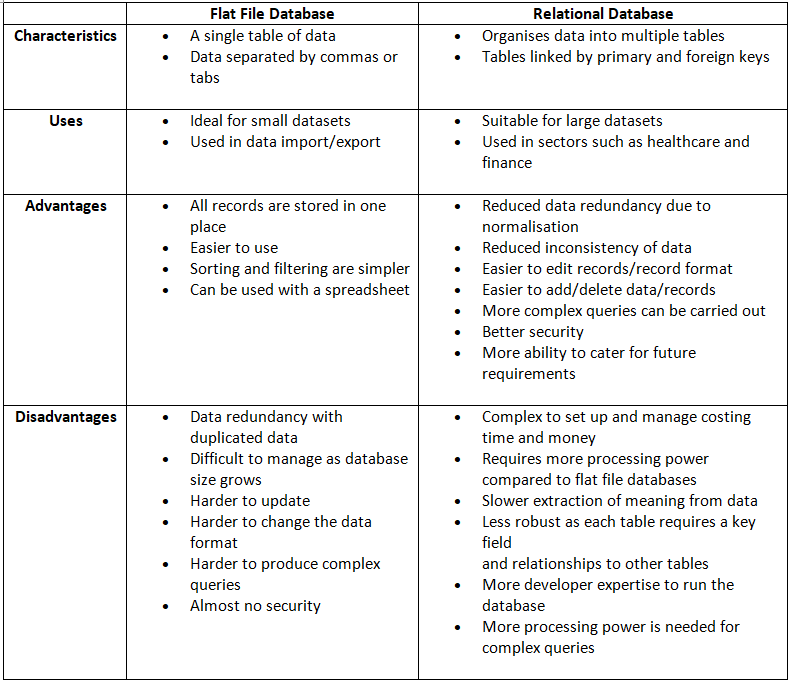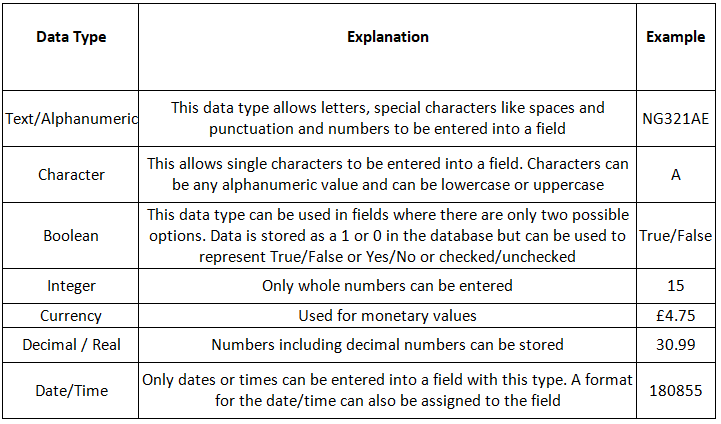Year 11 Exam > Year 11 Notes > IGCSE Information and Communication Technology Preparation > Types of Database
Types of Database | IGCSE Information and Communication Technology Preparation - Year 11 PDF Download
Flat File Database & Relational Database
- A database is an organized collection of data that allows for quick searching, sorting, filtering, and analysis.
- Data in a database can encompass various forms such as text, images, videos, and sound.
- Databases utilize tables to house data, with each table consisting of records represented by individual rows.
- For instance, consider a customer table containing records for different customers, each record segmented into fields like CustomerID, FirstName, LastName, DOB, and Phone Number.

Fields are represented by the columns in a table:
- There are 5 fields in the customer table
- The first row in a table contains the field names, which serve as headings for the data stored in those fields
- Each field in a table is associated with a data type that specifies the kind of data allowed in that field

Data Types
Import Data and Create Tables
- Data Import from Existing Files: You have the ability to bring in data from files such as .csv or .txt formats.
- Table Creation with Specified Field Names: By utilizing specific field names, you can generate tables for organizing data.

Field Data Types in Tables
- Understanding Data Types: Each field within a table is associated with a specific data type, such as text/alphanumeric, character, boolean, integer, real, and date/time.
- Example: If you assign the data type 'Integer' to a phone number, the initial 0 might be removed.
- Explanation: Phone numbers typically require the text/alphanumeric data type due to their initial 0.
Database Data Types


Setting Data Types and Sub-Types
- You have the ability to assign suitable data types to fields within a database.
- You can specify sub-types of numeric data such as percentages and the number of decimal places.
Setting Display Formats
- You can define how Boolean/logical fields are displayed, choosing between options like Yes/No, True/False, and Checkbox.
- Options include Yes/No, True/False, and Checkbox.
- You can determine the display format for date/time data entries.
Question for Types of DatabaseTry yourself: What is a field in a database table?View Solution
The document Types of Database | IGCSE Information and Communication Technology Preparation - Year 11 is a part of the Year 11 Course IGCSE Information and Communication Technology Preparation.
All you need of Year 11 at this link: Year 11
FAQs on Types of Database - IGCSE Information and Communication Technology Preparation - Year 11
| 1. What is the difference between a flat file database and a relational database? |  |
Ans. A flat file database stores data in a single table structure, while a relational database stores data in multiple tables that are related to each other through common fields.
| 2. What are the advantages of using a relational database over a flat file database? |  |
Ans. Relational databases offer better data consistency, scalability, and flexibility compared to flat file databases. They also support complex queries and relationships between data.
| 3. How does data retrieval differ between a flat file database and a relational database? |  |
Ans. In a flat file database, data retrieval may require searching through the entire file, while in a relational database, data can be retrieved using structured query language (SQL) which allows for efficient and targeted retrieval.
| 4. Can a flat file database be converted into a relational database? |  |
Ans. Yes, it is possible to convert a flat file database into a relational database by identifying relationships between data and restructuring it into multiple tables with related fields.
| 5. What are some common examples of applications that use flat file databases and relational databases? |  |
Ans. Flat file databases are commonly used in simple data storage applications like spreadsheets, while relational databases are used in more complex systems such as customer relationship management (CRM) systems and enterprise resource planning (ERP) systems.
Related Searches















